· 11 ·
Samuel Gragg and the Elastic Chair
MICHAEL S. PODMANICZKY
Samuel Gragg (1772–1855) created the elastic chair out of thin air (figs. 1, 2). Only rarely can such a bold claim be made about an early American craftsman. Changes in style and fashion, despite always being described as “new” or “newest,” were seldom true inventions since they arose from many different sources. The elastic chair, however, was something new: it embodied a major technical advance as well as an unprecedented, forward-looking design. Indeed, with its peacock-feather decoration (fig. 3), the elastic chair would have been perfectly suited for use and display in a late nineteenth-century aesthetic movement interior, including James Abbott McNeill Whistler’s Harmony in Blue and Gold, known as the Peacock Room.1
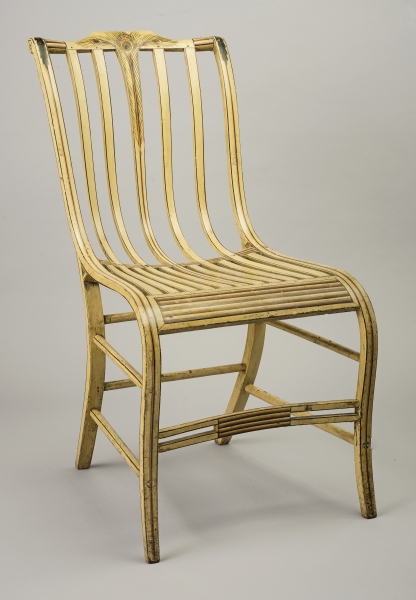
FIG. 1. Elastic side chair, Samuel Gragg (1772–1855), Boston, 1808–12. Birch, white oak, beech; h 34⅜, w 18⅛, d 25⅜. Winterthur Museum; Museum purchase (1961.0321).
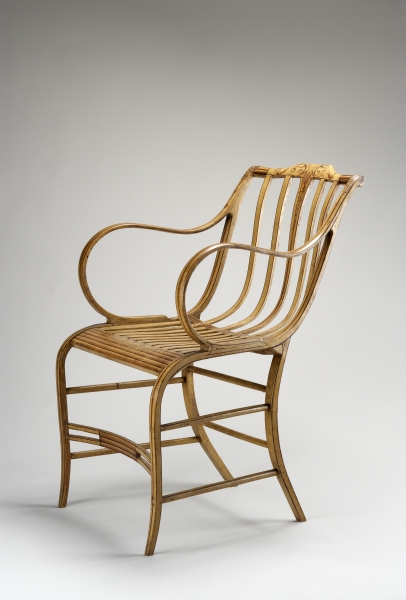
FIG. 2. Elastic armchair, Samuel Gragg, Boston, ca. 1810. White oak, soft maple, hickory; h 33¾, w 19⅞, d 25⅛. Carnegie Museum of Art; Berdan Memorial Trust Fund (2006.72).
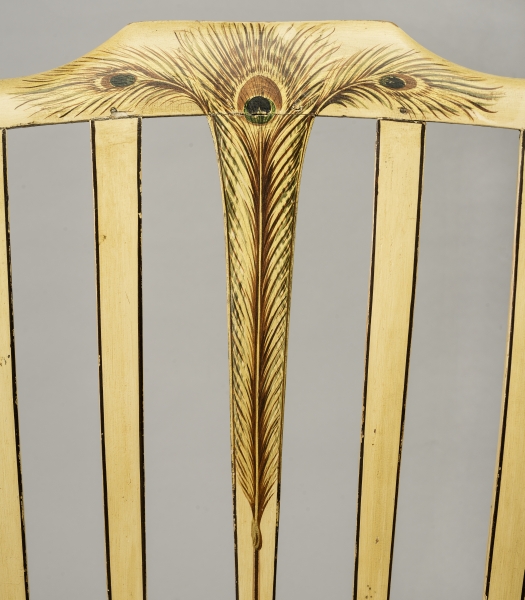
FIG. 3. Peacock feather decoration on the chair in fig. 1.
From a technical standpoint, the elastic chair was a non sequitur, and the construction techniques used to make it would not be employed again until the free-for-all of the twentieth century. Later curvilinear seating furniture, such as the kind produced by Jean-Joseph Chapuis and the Thonet Brothers, is of a fundamentally different conception.2 If one considers bentwood furniture as a genus, Chapuis’s work would be of the species “bent lamination” (strips of veneer glued and bent to shape over a form while the glue dries), and Thonet’s would be of a more mundane variety in which fantastical steam-bent wood elements were assembled into furniture using decidedly ordinary techniques, screws, and nails. One might even think of the elastic chair as the first piece of “studio” or “art” furniture, although those notions did not crystallize until well into the twentieth century.3 The elastic chair stands alone, whereas Thonet’s chairs, fifty years later, ushered in an era of similar bentwood seating furniture. Herein resides the story of furniture history’s “one-hit wonder.” Despite producing a masterpiece of Western furniture, Gragg has had only a minimal influence historically. Recent discoveries demonstrate that the elastic chair was in fact just a single, short burst of creativity by a craftsman during a long and successful, but otherwise prosaic, career.
The seminal essay on Samuel Gragg by Patricia E. Kane, published in 1971, established what was known of Gragg’s life at that time.4 Much information was gleaned from a genealogy written by his father, also named Samuel, including Gragg’s birth date of October 25, 1772, and birthplace of Peterborough, New Hampshire. In 2003, the exhibition “The Incredible Elastic Chairs of Samuel Gragg” was mounted at Winterthur Museum and traveled to the Milwaukee Art Museum. The exhibition, along with follow-up articles in Antiques and Antiques and Fine Art, accepted Kane’s historical account as a starting point but included technical analysis of surviving chairs to tease out a deeper perspective on Gragg’s innovations, principally by linking his fabrication techniques to those used by small-boat builders.5 During the course of the research for the exhibition, Gragg’s copy of the patent he was awarded for his “Elastic chair,” with his business card attached, was discovered, adding his own reflections on the chairs to the historical record (figs. 4, 5). After this personal milestone, Gragg mostly dropped the term elastic in favor of the more self-congratulatory, and perhaps less confusing, word patent.
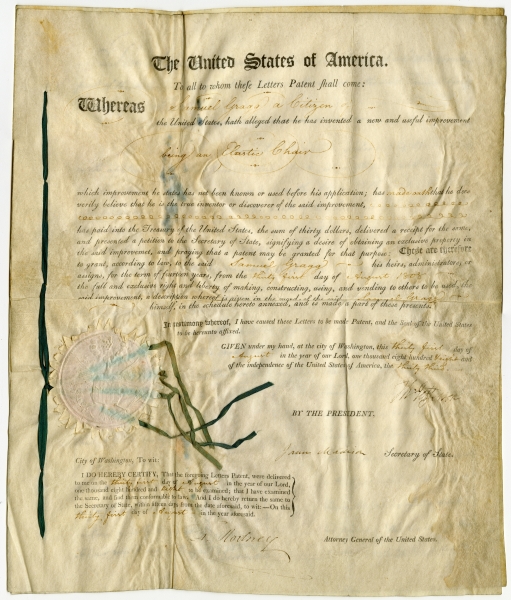
FIG. 4. Patent for “an Elastic Chair,” August 31, 1808. Carrier Library, James Madison University, Harrisonburg, Virginia.
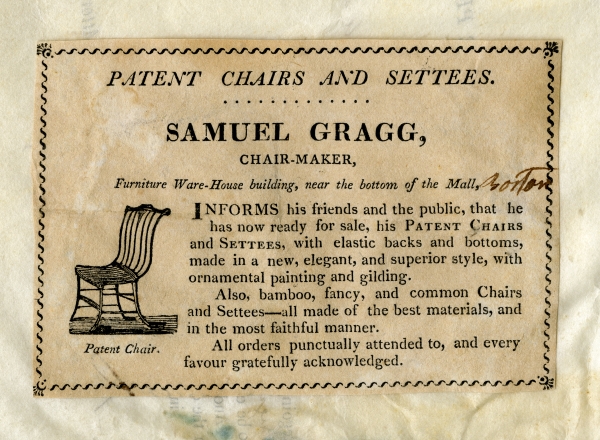
FIG. 5. Trade card of Samuel Gragg “CHAIR-MAKER,” ca. 1808. Carrier Library, James Madison University, Harrisonburg, Virginia.
Despite this new technical information, much of Gragg’s personal and professional life remained an enigma. Questions persisted about whether, and if so how, he received training before arriving in Boston, the quantity and character of his chair production, his relationship with other Boston craftsmen, the specifics of his sales, the artist(s) who executed the painted decoration on his chairs, and, perhaps most important, the success of his innovative chairs in the marketplace.
Answers to some of these questions have been found in documentation that has recently surfaced and is now housed in two public repositories. A trove of Samuel Gragg’s personal and professional papers was unearthed several years ago in the collection of the Arkansas History Commission in Little Rock.6 These include bills of sale, receipts, testimonials, ledger pages, and letters related to employees, other chairmakers, suppliers of materials, sales agents outside New England, and, most gratifying, painters who decorated his chairs. Another cache of papers was acquired by Historic New England in 2014. Although fewer in number than the documents in the Arkansas archives, these papers add greater weight and clarity to conclusions drawn from the collection in Little Rock.7
Kane summed up what was then known about Gragg’s family and early life. (The family’s penchant for spelling the name Gregg as well as Gragg has been a persistent source of confusion.8) His father, Samuel Gregg, left a genealogy, barely a thumbnail sketch of the many Greggs and their intermarriages. The elder Samuel spent some time working with “Uncle James,” a wheelwright who eventually moved to upstate New York, but the former chose not to pursue the trade, favoring farming instead. Nothing in this genealogy indicates that Samuel Gregg absorbed any trade skills.
As Kane noted, the younger Gragg went to live in the Mohawk Valley of New York for four or five years. What he did there is largely unknown, but he must have acquired some woodworking experience. It was also there that his first wife, Lucinda Campbell, died. Two of the recently found documents add dimension to what turns out to have been a traumatic time in Gragg’s life, and they explain much about what he brought to Boston in the way of trade skills.
One document is the commissioning of “Gregg” as a “Serjeant in Capt. James Boyds Company” in the first regiment of militia, Montgomery County, New York, on May 18, 1799.9 Accepting this commission would suggest Gragg’s contentment with his lot in upstate New York and an attitude of permanence. But a second document, dated July 12, 1799, indicates a dramatic and tragic turn, possibly precipitated by the death of Lucinda. It is a list of household and trade items, nearly everything Gragg owned, to be sold by one Daniel Holden, as well as a list of creditors that Holden agrees to settle with after the sale.10 The list includes everything from a shaving mirror to a bedstead, meat to a bottle of gin, but most importantly his woodworking tools, a “Great Wheel,” “A Quantity of Wheel Timbers,” and a “Sett of Wheel Rights Tools.” Clearly, Gragg had been trained as a wheelwright by his father, uncle, or both, and he practiced that trade while in New York. Where some might see the “Great Wheel” as indicative of Windsor chairmaking experience, it was more likely used to produce wheel hubs, thicker and heavier than chair legs and thus more expeditiously turned with constant rotation, powered by an assistant. (Chair parts were usually turned on a one-man, reciprocating, spring lathe.) Furthermore, the inventory specifies the tools and materials used by a “Wheel Right.” The list provides no evidence that chairmaking was part of Gragg’s enterprise at this time.
Upon the death of Lucinda, Gragg gave up almost everything, even his portable hand tools. He headed east, presumably back to his family in Peterborough, before making his most important career decision: to move to Boston. He shipped what remained of his belongings from Portsmouth and paid for their storage between December 1, 1801, and January 9, 1802.11
Gragg arrived in Boston with specific trade skills that related closely, and thus were easily applied, to chairmaking. That he made the conversion indicates a flexible and adventurous entrepreneurial spirit. He established a partnership with chairmaker William Hutchins, first on Court Street and then moving to 25 Hanover Street in 1804.12 Gragg wed Elizabeth Hopkinson on September 10, 1801, and Hutchins married Gragg’s sister Betsy in 1806.13
The two caches of freshly discovered documents do not cover all of Gragg’s years in Boston. They begin with his arrival in the town but are concentrated around the years of his elastic chair production, primarily 1808–11, and then skip to the early 1820s. Only a scattering of papers treat the years afterwards, ending with his death in 1855. The earliest receipts are for rent for living accommodations at the time the business moved to Hanover Street, although the address is not noted. Along with these are many receipts for food, clothing, schooling for his daughter Elizabeth, and even his bar tab for wine, rum, “Cherry,” and “Lisbon.”14
Unfortunately, few of the documents shed light on Gragg’s chairmaking partnership with Hutchins, and the question remains: What exactly did Gragg bring to the relationship? He must have convinced Hutchins of his potential based on his wheelwright training; perhaps he demonstrated an innate entrepreneurial élan, which would dovetail nicely with Hutchins’s established chairmaking skills. Highly skilled tradecraft and entrepreneurial gusto are both manifest in Gragg’s activities after he absorbed what Hutchins had to offer over their six years in business together. Still, Gragg’s professional life is relatively opaque until 1808, when he introduced the elastic chair. Speculation about the genesis of that chair, and its designer’s progress to notoriety, must be based on the singular events in that year.
Elastic chairs have always excited scholars as both beautiful objects and historic oddities, but their uncommon technical details kept researchers at arm’s length. They have been catalogued somewhere between the common stick-constructed Windsor chair and the elegantly joined, high-style, mahogany klismos-form chairs of the period. In reality, they have little to do with either. Without fully considering the technology of the elastic chair and its highly unusual construction details, scholars have concentrated more on Gragg’s life, sparse as the information was, and the overall form and possible design precedents for the chairs.
How did Gragg determine the construction techniques necessary for the elastic chair? What inspired him? Kane has pointed to period designs of the klismos form by the English connoisseur Thomas Hope which depict a back stile that flows seamlessly into the seat rail (fig. 6). What may look like a back leg applied to a continuous back/seat rail would hardly have driven a craftsman to an entirely new construction method simply to be true to a print source. Witness the uncountable numbers of chairmakers who produced the klismos look but with traditional construction techniques (fig. 7).
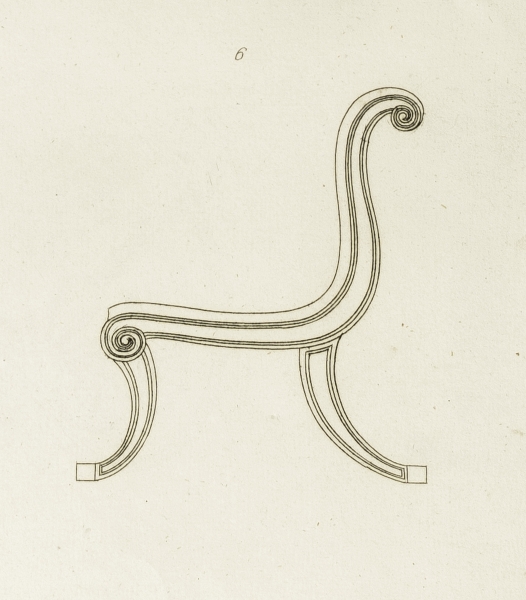
FIG. 6. “Side view of a chair.” From Thomas Hope, Household Furniture and Interior Decoration (London: Longman, Hurst, Rees, and Orme, 1807), pl. 40, no. 6. Winterthur Library; Printed Books and Periodicals Collection.
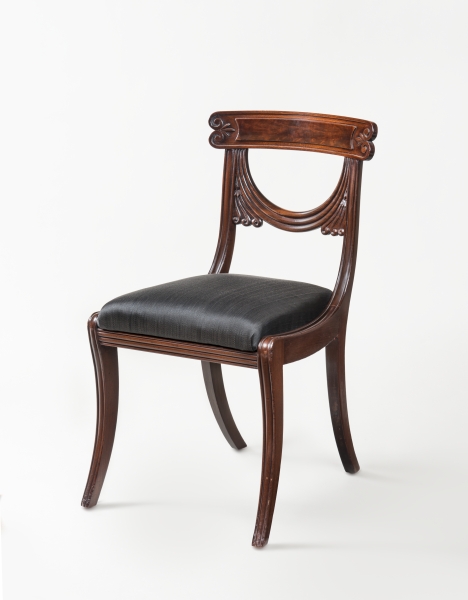
FIG. 7. Side chair, Boston, 1815–25. Mahogany, birch; h 32, w 18, d 21. Gore Place Society (1991.7). Photo, Gavin Ashworth. This chair follows traditional construction techniques in which the rear stile and rear leg are one piece and the side seat rails are tenoned into the continuous stile and leg.
Although heavily indebted to Gragg’s imagination and vision, the elastic chair was clearly a classical design, based on the klismos form that originated in Egypt and was further interpreted by the Greeks and Romans. For structural reasons, designers such as Hope offered the heavier and more robust Roman version. The klismos, as illustrated on Greek amphorae, was light and sinuous compared with later Roman types. The Egyptians and Greeks built their chairs using carefully selected and painstakingly worked timbers that were already close to the desired shape, that is, “knees” and “crooks” of tree branches that had grown to the desired curve. This ingenuity allowed for a significant reduction in the cross-sectional dimension of the various elements, thanks to the strength provided by the continuous wood grain of the naturally curved stock. The technique did not lend itself to even limited production work. Original klismos chairs were surely few and only for the elite.
Nineteenth-century makers did not have the luxury of preshaped timbers, and cutting those sinuous shapes out of straight-grained timber produced areas of short grain prone to breakage. This problem was remedied by favoring the heavy, Roman interpretation of the klismos. Extra-thick timbers were cut to the curvatures, with enough cross-sectional dimensions to (usually) overcome the tendency to break along short grain. The never-produced Hope chair is almost a cartoon version of the transmogrification that original Egyptian and Greek versions had to endure to be produced with typical nineteenth-century materials and techniques. Hope did not indicate joints, but surely he intended his chair to be constructed in the traditional manner with a continuous rear leg and back stile to which the seat rails were attached with mortise-and-tenon joints (see fig. 7). Once assembled, the whole would be deftly carved to simulate a continuous back stile and seat rail.
There is no evidence that Gragg experimented with this approach to the klismos chair. His fancy-chair work does not utilize mortise-and-tenon joinery. After all, Gragg was a stick-furniture maker, not a cabinetmaker. It is more likely that in trying to respond to the demand for the fashionable klismos design, he came upon a different approach to wood construction that was similar enough to his own to prompt a eureka moment, when he saw the potential for its special application to klismos-chair making.
His activities in the years leading up to and including 1808 are consistent with this notion of a design thunderbolt. First, after a final payment to Hutchins for rent of his house and shop on January 1, 1808, Gragg dissolved that partnership. (The dissolution was finalized on December 19, 1808, when Hutchins agreed to pay half of what was “due the late Gragg & Hutchins.”) Two months later, Gragg announced in the Independent Chronicle that he was moving what he referred to as “his fancy chair factory” to the fashionable South End, taking space in Thomas Seymour’s furniture warehouse, where he would offer “all kinds of Fancy and Bamboo CHAIRS.”15 This statement was repeated in various places, including on his trade card (see fig. 5) and in a handwritten announcement, presumably for a newspaper ad, dated May 1, 1809.16
The term fancy can be misleading since it usually implies a high level of sophistication. That may be true for the chairs’ painted decoration, but the construction techniques, derivative of Windsor-chair making, are simple compared to those used for mahogany, walnut, or, occasionally, rosewood chairs of similar style. However, Gragg introduced a dramatic new design for fancy furniture worthy of the term. On August 31, 1808, he received a patent for chairs and settees that he described as “Elastic.” Because the patent office burned in 1836, destroying earlier records, this event was known until the end of the twentieth century only by the word PATENT embossed on the underside of many of his chairs (fig. 8) and from Gragg’s newspaper announcement and trade cards proudly proclaiming the same.
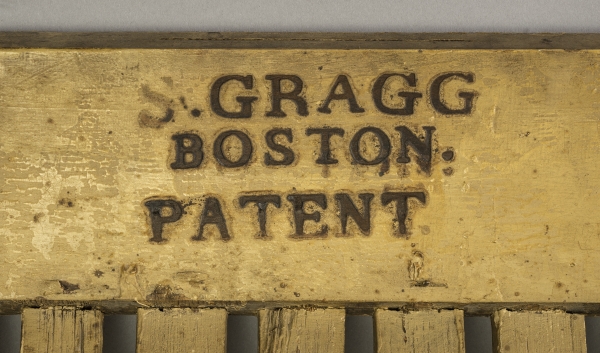
FIG. 8. Brand on underside of front seat rail of the chair in fig. 1.
In 2003, research for an exhibition of Gragg’s work brought to light his personal copy of the patent to which was attached his business card (see figs. 4, 5).17 The document included not only the stamped and sealed patent, signed by President Thomas Jefferson and Secretary of State James Madison, but also a second page describing the construction process and salient marketing points that Gragg drew upon for his newspaper announcement.
An examination of the chairs today reveals techniques that most closely resemble those used in small watercraft construction, suggesting that Gragg’s eureka moment occurred on the waterfront, perhaps (we might speculate) in the boat shop of a friend. The most prominent feature, and the one that has fixated the historian’s gaze, is the use of wood elements bent into shape after being made pliable with heat, either by hand or via the application of steam or boiling water. (For less dramatic curves, “green” wood of thinner dimensions can be bent and allowed to dry, holding its shape.) Gragg’s use of bentwood in such novel ways is noteworthy. But bending wood is virtually second nature to most woodworkers, in particular boat- and shipwrights, and certainly to Windsor-chair makers and wheelwrights. Gragg’s familiarity with the technique meant that his imagination was fertile soil once he recognized the connections between boat and chair. More important is the way that Gragg joined the sinewy elements once they were bent.
Gragg offered two types of elastic chairs. One was the patented chair (and related settees) as pictured on his trade card, with continuous back stile and seat rail (fig. 9; see also fig. 5). The back and “goat hoof” front legs are socketed in place. The other, more radical version, with a continuous back stile, seat rail, and front leg, is sometimes referred to today as “fully elastic” (see fig. 1). The latter more fully illustrates the innovative boatbuilding-related techniques that Gragg introduced into furnituremaking.
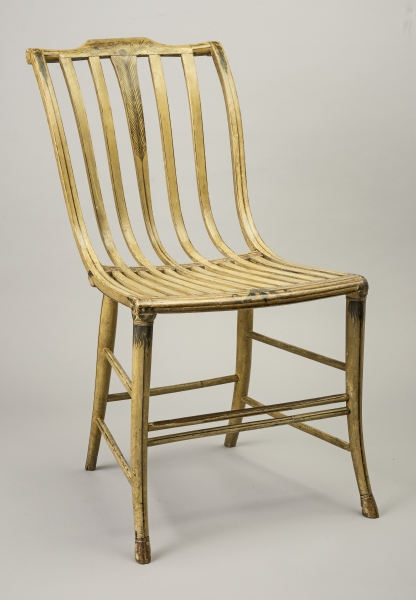
FIG. 9. Side chair, Samuel Gragg, Boston, 1808–12. Oak, hickory, beech; h 34, w 19, d 23¾. Winterthur Museum; Gift of Mr. and Mrs. Charles F. Montgomery (1969.0209.002).
Regardless of the size of the boat, its construction follows a step-by-step, piece-by-piece procedure. It begins with the foundation, a carefully shaped and prepared keel, to which additional pieces are fitted, and then pieces are fitted onto those, and so on. Boat construction features many permutations of the lap joint held together with a metal fastening. In direct contrast, Windsor chair parts, with turned tenons and drilled sockets, were often made in advance and fitted together all at once.
The elastic chair begins with a keel of sorts: the shaped rear seat rail, most likely clamped in a jig with the steam-bent serpentine side elements then fitted into notches at either end and screwed in place (figs. 10, 11). Once this foundation was set, the crest rail and front seat rail were placed in the locations they would assume, and the areas of overlap traced onto the rails and bentwood elements. These lines would be partially sawn through and the waste chiseled away to form a half-lap joint. The crest and seat rail would then be relocated, the joint interface precisely fitted with a stroke or two of a paring chisel, and finally all joints were fastened together with screws (fig. 12). During this initial assembly, the serpentine side elements were further twisted and sprung apart to create the splay of the back and seat—“putting the twist in,” as boat builders refer to jockeying bent frames into position. This step establishes the overall shape for the chair. Next, a lap, or more precisely an angled scarf joint, between the rear legs and seat rail was cut, fitted, and screwed in place (see fig. 11). The undercarriage stretchers were socketed to the legs. Even Gragg’s traditional socketing was innovative. Because the continuous grain of the bentwood allowed the “scantlings” (dimensions) of the side elements to be so radically reduced in thickness, Gragg ensured a solid joint with maximum holding power by piercing the legs with the round tenons of the front-to-back stretchers and wedging them from the outside.
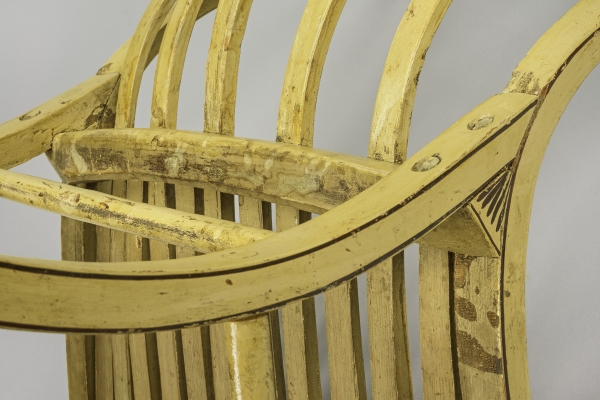
FIG. 10. Underside of rear seat rail of the chair in fig. 1. Two screws secure the rear legs to the rear seat rail and bentwood rear stile.
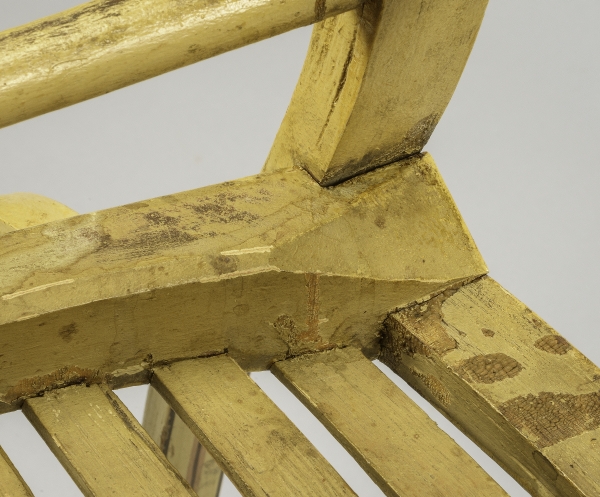
FIG. 11. Rear corner of seat of the chair in fig. 1. The rear seat rail is notched to fit around the rear leg and to receive the bentwood side seat rail (which is a continuation of the rear stile).
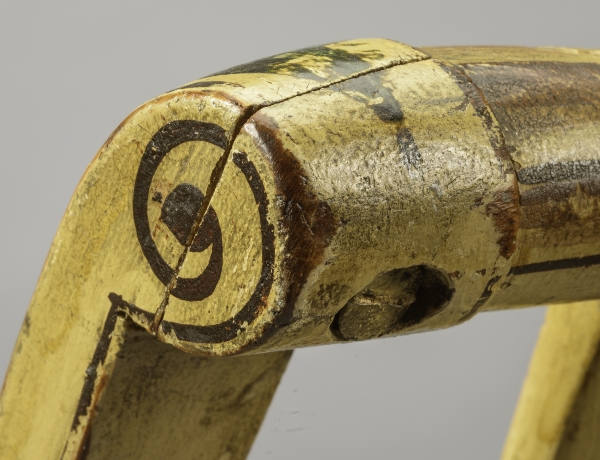
FIG. 12. Corner of crest rail of the side chair in fig. 1. The crest rail is notched to receive the upper end of the front stile. A screw, visible from the back, secures the half-lap joint of the crest rail and rear stile.
The back and seat slats further demonstrate a relationship with boatbuilding. The strength of a boat, and of an elastic chair, is derived from the compound curves that are established by varying the curvature of bent elements. The back of the chair can be seen to belly out as the curve of the slats increases toward the chair’s midpoint. Each of these slats was painstakingly cut with a tab on the top that aligned with a slot in the crest, fitted through notches in the rear seat rail, and then dovetailed to the front seat rail (fig. 13). The twisting, bending, and custom fitting of each of these elements, as well as the shorter slats that filled in between the full-length slats in the seats, added tremendously to the time required to assemble the chair. Still more time was needed after assembly to carefully plane and scrape all the joints and interfaces to smooth, fair curves. All this painstaking and time-consuming effort was the fatal flaw in what was otherwise a brilliant design.18
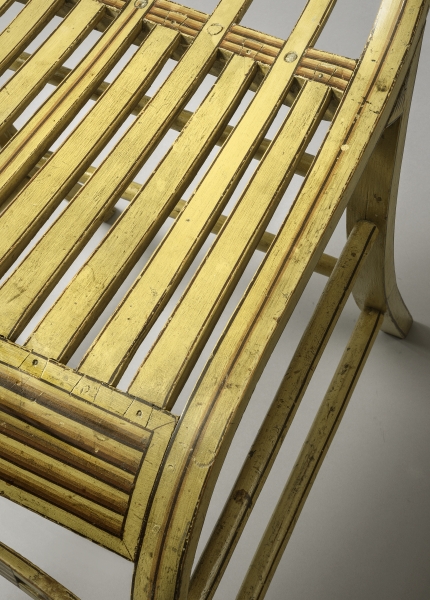
FIG. 13. Seat of the chair in fig. 1. The slats in the seat are dovetailed to the front seat rail and notched or dovetailed to the rear seat rail. Small finishing nails or larger screws fasten these slats in place.
It cannot be coincidental that Gragg moved into Thomas Seymour’s warehouse and introduced the elastic chair within a few months of parting ways with Hutchins. Kane notes that Hutchins stayed in the North End workshop. One can only imagine the atmosphere there as Gragg, Hutchins’s brother-in-law and former partner, tried to break out professionally with new products and a move that aligned him with one of the most prominent businessmen in the city.
Gragg seemingly was trying to ride the elastic chair to greater personal prominence and perhaps less physical labor for himself. His business relationship with Seymour is reflected in a handful of accounts in the Gragg papers beginning on July 18, 1807, six months before Gragg moved in with Seymour. The cabinetmaker later billed Gragg for “Rent of Shop from Jan. 1 to Apr. 1, 1808. @ $150 . . . 37.50.” In total, from July 1807 to July 1808, Gragg’s transactions with Seymour amounted to the sizable sum of $1,162.44.19 It is easy to imagine that Gragg had experienced his eureka moment earlier in 1807 and immediately began developing his new chair, jockeying for a conspicuous place in the city to market it. Completion of the prototype and submission of the patent application must have prompted his aggressive move to the South End before the patent was awarded. Gragg was counting his chickens, secure in the belief that he would be successful. The project was well under way when Gragg’s second wife died in March 1808, again at a turning point in his life and in the midst of a rapid business expansion.
Gragg not only rented shop space from Seymour but also used him as an agent for the goods, primarily chairs, that he produced. Over a twelve-month period beginning in July 1807, Seymour sold on behalf of Gragg 116 “Fancy” chairs, 134 “Bamboo” Windsor chairs, and assorted other bits of furniture such as stools, rocking chairs, and “crickets.” (The one “Gragg” branded Windsor armchair [fig. 14] demonstrates that his approach to Windsor construction and form was decidedly mainstream and did not incorporate the curvilinear/serpentine features associated with the elastic chair.) Seymour also credited Gragg on occasion for painting or fixing chairs. No mention of “Elastic” or “Patent” chairs appears, although some of the fancy chairs may be early examples of the yet-to-be patented innovation. Gragg must have been champing at the bit. But given his inflated expectations, evinced by the enthusiasm of his upcoming public announcement, Gragg may have been paranoid of being scooped if he introduced the elastic chair before having patent in hand.
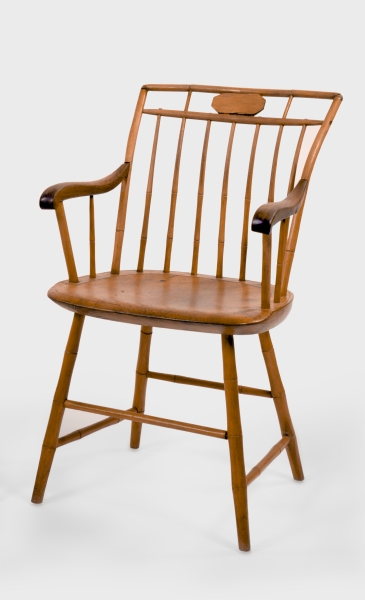
FIG. 14. Windsor armchair, Samuel Gragg, Boston, 1805–20. Maple, oak, white pine; h 34½, w 21, d 19½. Private collection. The underside of the seat is branded “S.GRAGG / BOSTON.”
Determining exactly what Gragg himself was doing in the shop is difficult. Ample records reveal that he paid for regular work from employees, some presumably in his shop. One such employee is John Rollings, who worked with Gragg in 1808. His activities are listed on receipts by the workday or some fraction of a day or, more specifically, “to making Eighteen fancy chairs,” “to Carrying Chairs to Wigins,” “to Trimming one Dozen of Chairs,” and so on.20 On August 13, 1810, Gragg paid Simon Sanborn $177.50 for “Making Chairs and other work from March 19th . . . to August 13th,” again presumably, but not necessarily, in Gragg’s workshop.21 Gragg also paid Stephan Bradshaw for extensive work on several occasions in 1809, including “Makin” and “Bottomin” chairs.22
Gragg outsourced to various craftsmen and merchants around Boston as well. For example, on July 3, 1807, he bought 236 chair seats from William Parkhurst for $39.33. In 1809, he acquired forty-two seats for armchairs for $7 from another local craftsman. The next year, the sawyer William Cooper provided Gragg with 346 bamboo-chair seats, ranging in price from 8 to 14 cents each. Between December 1808 and May 1809, Peter Wilder supplied Gragg with “Stock for 200 fancy chairs[,] . . . 100 single top bamboo” chairs, and “72 Rocking Chairs,” receiving payment on September 28, 1809. Receipts survive also for a wide range of tools, fastenings, paints, pigments, and even gold leaf.23
The most revealing information about the painting of elastic chairs comes from records of painters and decorators hired by Gragg. Furniture historian Robert D. Mussey Jr. has reasonably speculated that John Ritto Penniman, a prominent portraitist and decorative painter, was among them, based on the strength of Penniman’s working relationship with Seymour, Gragg’s landlord and agent.24 Indeed, among Gragg’s papers are three receipts from Penniman, the first two indicating the painter’s involvement with the birth of the elastic chair. In one, dated August 9, 1808, Penniman charged $1 for “Ornamenting a moddle of a Chair.”25 In another, from December 30, he billed for “painting 1 elegant Patent Chear as a Model” at $10.26 Given the costs, it is reasonable to conclude that the first charge refers to a miniature, plausibly a patent model, and the second for painting a full-size marketing prototype. Since both men were associated with Seymour, we can assume that Gragg would turn to Penniman for work of the highest quality to shine the most favorable light on his special chair. However, when it came to producing and selling the elastic chairs, apparently Penniman was too rich for Gragg’s blood. In fact, there is only one receipt from Penniman to Gragg, dated August 4, 1809, for painting and gilding a set of twelve patent chairs bought by a Mr. Parsons (fig. 15). The reference to gilding virtually guarantees that these were peacock-feather-decorated examples.
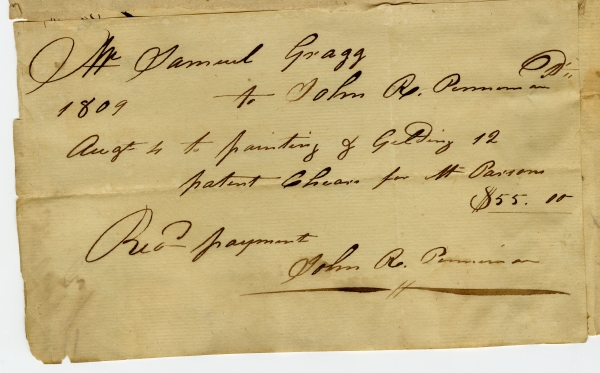
FIG. 15. Receipt, John R. Penniman to Samuel Gragg, August 4, 1809. Arkansas History Commission, Little Rock.
Thankfully, Penniman included the client’s name, which allows for cross-referencing with the surviving Gragg and Seymour account book (pages of which are in the Arkansas History Commission archives), wherein is found an entry dated August 3, 1809, for twelve “Elastick Patent” chairs to “Parsons” for $120.27 Gragg was sailing close to the financial wind, paying Penniman for work done sometime in the past the day after Parsons paid for the chairs. Perhaps he had no choice given the size of Penniman’s bill, which represented nearly half the total cost of the chairs. The final price of the set at $10 per chair is the highest amount found in the records for patent chairs and well above the average price for fancy or bamboo chairs. Gragg paid a premium for Penniman’s services, and consequently chose to employ him on only a few key commissions.28
The vast amount of Gragg’s trade with other painters went to John McDuell, Samuel Gaute, and Asa Parks. In one document, McDuell is paid $24 for “12 yellow Peacock” chairs, less than half of what Penniman charged. In contrast to his limited trade with Penniman, an account with McDuell dated January 13, 1810, includes, along with many fancy chairs, one hundred patent chairs. In addition, on June 18 and October 1, 1810, Samuel Gaute submitted receipts for extensive chair decoration.29
As reflected in the Seymour accounts, other than the set of Penniman-painted elastic chairs and a handful of other patent chairs, Gragg’s sales consisted overwhelmingly of fancy and bamboo chairs. There is also a notable absence of any reference to patent or elastic chairs in Gragg’s outsourcing or employee records. A plausible conclusion is that Gragg was an energetic and reasonably successful fancy-chair maker and agent who outsourced or hired materials and labor for the making, painting, and marketing of mainstream seating furniture (see fig. 14; see also fig. 15). Parallel to this business, however, he also threw himself into his innovative elastic chair initiative, most likely applying his skills and energy to the making and promotion of these chairs, jobbing out the painting to McDuell, Gaute, and Parks. A stock-in-hand record of June 18, 1810, lists 91 elastic armchairs and side chairs, along with 24 that were unfinished (fig. 16). However, the few existing records of sales of these chairs clearly indicates that all was not going well with Gragg’s innovative designs.
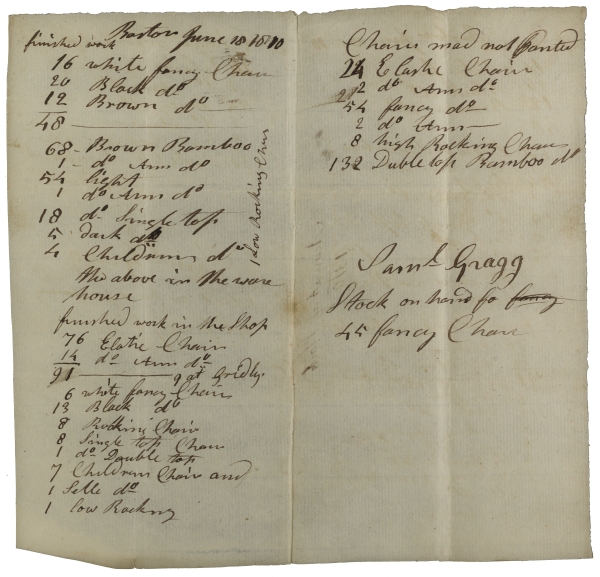
FIG. 16. Account of “finished work” in the warehouse and shop, chairs “mad[e] not pa[i]nted,” and “Stock on hand,” Samuel Gragg, June 18, 1810. Historic New England.
Another indication that Gragg may have begun to feel desperate is the record of his attempt, as early as summer 1809, to find markets beyond Boston and, indeed, outside New England. On August 28, he shipped “3 Packages” of two chairs each by the schooner Gorham Lovell, captained by Jesse Lewis, to “Mrss. Nichols and French” of Baltimore (fig. 17). On December 12, 1809, Gragg received a letter back from William French, who wrote:
Sir, I have got all the information respecting the Chairs thats in my Power. It is in my opinion that in case you were to forward a half a Doz of the New Pattern + a Settee with two of the arm Chairs, it would probably have a better tendency [i.e., be a better way] to introduce them. I am informed they can be painted here for $2 per Piece it might be best probably to send the unpainted in the future, these you now send better be well finished and will exercise all my talents to get them in repute. Yours respectfully, Wm French
This letter is followed by one dated March 20, 1810, from Lewis to Gragg, in which the captain promises to deliver “Eight Elastic Chairs” to French in Baltimore, adding a $3 freight charge to the cost of the chairs.30
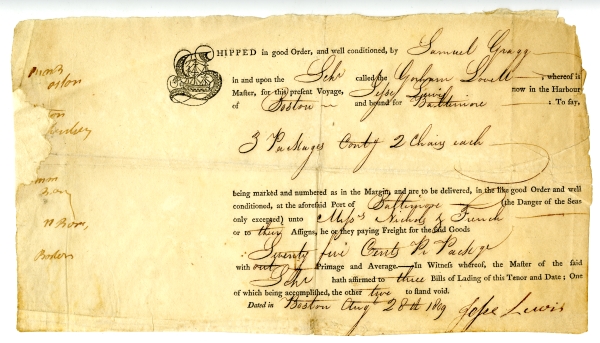
FIG. 17. Shipping manifest for the schooner Gorham Lovell, Jesse Lewis, master, August 28, 1809. Arkansas History Commission, Little Rock. Samuel Gragg consigns six chairs for shipment to William French of Nichols and French, Baltimore, Md.
On April 4, 1810, French announced in the Baltimore Federal Republican that he had just received and was offering for sale a wide range of items and dry goods, including “A few sets patent Chairs of the latest fashion, and of a superior quality” (fig. 18).
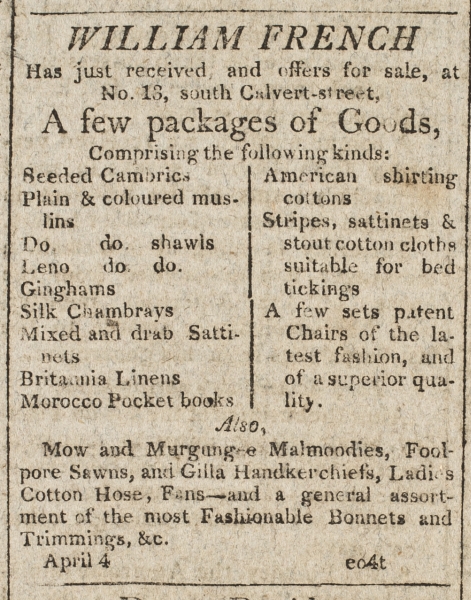
FIG. 18. Advertisement of William French. From Federal Republican (Baltimore), April 4, 1810. American Antiquarian Society.
A letter from French to Gragg dated April 21, 1810, further illuminates the business arrangement. French states that he received “the 8 Chairs in good order” and “Sold the 6 Chairs that was painted at $8. Each by the way of introducing them” (referring to the first order quoted above). The lower price may have made them salable, but not particularly attractive to Gragg, who was looking for more lucrative markets. French optimistically suggests that Gragg send twenty dozen chairs, of which five dozen should be armchairs, the latter to sell at $10 “if neatly painted.” French indicates that he would have the remaining chairs from the current shipment painted if he doesn’t sell them quickly, indicating that Gragg’s second shipment was unpainted. French writes that he received indications the armchairs would be suited to “entrays” and the finished versions would sell quickly if they could be priced at “6 to 7 dollars,” well below the tantalizing price of $10 paid by Parsons for what were presumably side chairs. Gragg could save the shipping, keep them in Boston, and no doubt sell them at the bargain price, although that also would hurt him financially.
These records firmly establish that the decoration of Gragg’s chairs was not confined to Boston painters, and the various “non-peacock” paint schemes that are known may very well be the product of artisans and decorators working far from the home port of the elastic chair.
Concomitant with his initiative in Baltimore, Gragg was looking even farther afield. Perhaps he was frustrated, given the length between the time he first sent chairs to French and when he heard back from him. On September 30, 1809, he shipped a dozen chairs to Cuba with schooner captain William Partridge. In this case, he incurred a greater shipping cost, $15, more than a dollar a chair.31 The reception for his chairs there was even less heartening than in Baltimore.
On December 14, 1809, Gragg received a letter from Havana, reading in part, “Capt. Berry of Gorham left in our hand, a doz. Patent chairs for sale on your account.” The letter goes on to state that the best they could get for the chairs was $6, and only one person was offering that amount. Furthermore, the chairs were becoming damaged in storage.32 One would think that this news would have discouraged Gragg from further exploration of markets in the Caribbean and parts south, and yet, in May 1810, a sale of six chairs in “Sierra Leone, Africa” is recorded.
In Baltimore, Gragg had successfully implemented a plan to market his chairs and secured an agent to work with him. Unfortunately, as he must have seen it, the city was not the lucrative market he needed to rescue his elastic chairs. On August 8, 1810, Gragg received a demand note from James Whitaker of Philadelphia for the considerable sum of $480. Although the reason is not mentioned in this or any other related document, the debt most likely has to do with the chair trade and possibly refers to unsuccessful business dealings in Philadelphia, a stop on the way to Baltimore. Still, as the records show, Gragg pressed on with production back in Boston. Less than two months before receiving the demand note, Gragg’s stock-in-hand record shows a large number of unsold elastic chairs, not a good sign, and at some point (we may surmise) his business head finally got the better of his heart.
In a transaction that must have broken that heart, on July 25, 1810, Gragg sold partial rights to his patent chairs for $500 to the New York chairmakers Charles Marsh and Joseph Riley.33 Gragg seems to have retained his patent rights in New England, but no evidence survives to indicate that he actively pursued his dream of a flourishing elastic chair business. Looking ahead, it was a wise business decision. In 1822, Gragg paid George Curtis $191.98 for providing dozens of chairs, rocking chairs, and settees in various styles, including “bamboo” but not “fancy,” suggesting that Gragg had indeed become a lasting successful businessman, albeit in a much more banal and mundane industry.34 As with the authors of the more familiar one-hit-wonders of today, Gragg had to have maintained a warm spot in his heart for that brief burst of youthful creativity that would always distinguish his career.
Surviving receipts for food, drink, clothing, firewood, and tuition for his daughter Elizabeth all attest to a financially secure man in the forty-five years after Gragg’s elastic chair era. His citizenship and membership in the Masons are affirmed in a surviving handwritten eulogy extolling his character and worth. Noting that he was “an industrious, honest, and good man,” the author, in a somewhat unfortunate turn of phrase, states that “he had left the odor of an unspotted name” as his legacy.35
Samuel Gragg died on December 21, 1855. In a final irony, the records of Mount Auburn Cemetery in Cambridge note that Samuel “Gregg” was buried on Laburnum Path, plot 2579, on December 23, 1855.
* * *
I would like to thank Philip Zimmerman, who assisted me in gaining access to important material, and Robert Mussey, a willing sounding board and selfless source of information.

1. The Peacock Room is part of Freer Gallery of Art, Smithsonian Institution, Washington, D.C.
2. Gragg’s position in the trajectory of bentwood furniture was addressed in the exhibition and publications mentioned in n. 5.
3. It is not insignificant that the book by Charlotte Fiell and Peter Fiell entitled 1,000 Chairs (Cologne and New York: Taschen, 2005), a survey of the artistic and technological progress of modern seating furniture, begins with Samuel Gragg’s elastic chair.
4. Patricia E. Kane, “Samuel Gragg: His Bent-wood Fancy Chairs,” Yale University Art Gallery Bulletin 33, no. 2 (Autumn 1971): 26–37.
5. See Michael Podmaniczky, “The Incredible Elastic Chairs of Samuel Gragg,” Antiques 163, no. 5 (May 2003): 138–45; and Michael Podmaniczky, “Hands-On: The Elastic Chairs of Samuel Gragg,” Catalogue of Antiques and Fine Art 4, no. 3 (Summer 2003): 166–67. See also Michael Podmaniczky, “The Incredible Elastic Chairs of Samuel Gragg,” Winterthur Magazine (Winter 2002): 14–18.
6. The Gragg/Gregg papers, 1799–1892 (MS.000271), are at the Arkansas History Commission (State Archives), Little Rock (hereafter AHC). They were acquired from Myra McAlmont Vaughan and Martha Vaughan Mashburn, both of Little Rock, and contain 6.5 cubic feet of documents pertaining to the Samuel Gragg and Washington Parker Gregg families of Boston.
7. Historic New England (hereafter HNE) purchased its collection of Samuel Gragg papers in 2014. The collection contains 171 items dating from 1801 to 1810. HNE acquired a second cache of papers in 2015.
8. A tangential point of interest in this inquiry concerns the spelling of Gragg’s surname. He was born with and known by the family name Gregg before arriving in Boston and had no apparent reason to change it—and yet he did. Could it have been to distinguish himself from his father, also named Samuel? There is no record of the abbreviation Jr. or Sr. being used. Perhaps it was simply a casual decision to distinguish himself from all other Greggs, and the change was never legal. Boston marriage records refer to him as “Gregg” in 1801 (see Kane, “Samuel Gragg,” 32). The name may even have jumped generations, for Gragg’s son Washington Parker seems to have eventually used Gregg. Washington’s twin brother Jefferson signed a letter to his “Dear Father” dated June 12, 1821, from Havana “your dutiful son Jefferson Gragg.” Washington Parker appears to have joined the bar and become a published authority on railroad law, whereas Jefferson stayed close to his father’s business. See AHC.
9. AHC.
10. Ibid.
11. Both documents are in the HNE collection.
12. Kane, “Samuel Gragg,” 32.
13. Ibid., 32.
14. Documents cited in this paragraph are in the AHC collection.
15. Kane, “Samuel Gragg,” 33.
16. Affixed to patent, AHC.
17. Podmaniczky, “Incredible Elastic Chairs,” Antiques, 140.
18. For Gragg’s techniques, see also Donald C. Williams, “Replicating Gragg,” American Period Furniture 11 (2011): 46–55.
19. Ledger pages, AHC.
20. “Trimming” referred to the cutting of leg bottoms to fit to the floor; confirmed by Nancy Goyne Evans, telephone conversation with the author, Nov. 8, 2013. The process probably included smoothing joints and interfaces with a cabinet scraper once a chair was assembled, no small task with an elastic chair.
21. AHC.
22. Ibid.
23. Documents cited in this paragraph are in the AHC collection.
24. Robert D. Mussey Jr., The Furniture Masterworks of John and Thomas Seymour (Salem, Mass.: Peabody Essex Museum, 2003), 315. A Penniman biblical scene hangs on the reredos of Old North Church, Boston.
25. HNE.
26. Ibid.
27. AHC.
28. Ibid.
29. HNE.
30. Documents referenced here are in the AHC collection.
31. Ibid.
32. Ibid.
33. Ibid. Scattered throughout the nineteenth century are many bentwood chairs with some characteristics similar to Gragg’s, but sadly falling far short of the brilliance of his design. It is possible that some of these might represent the new patent-rights holders’ unsuccessful attempts to simplify the design in order to make it more economical to build.
34. Ibid.
35. Ibid.
